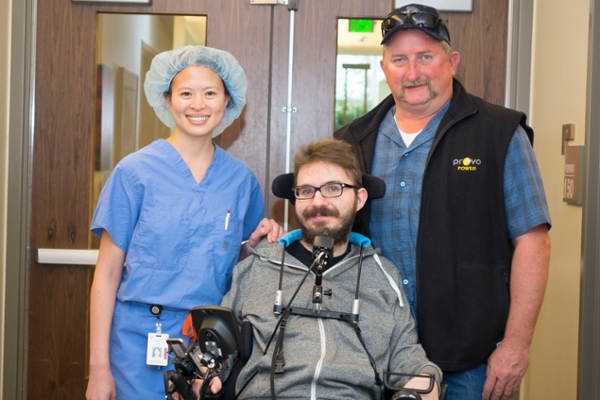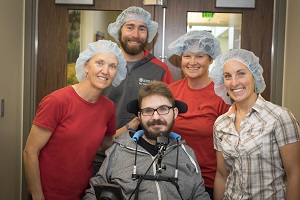 For a decade, 30-year-old Marshall Burningham worked hard to have his own internet technology business. Working for Apple, he traveled the world to hone his tech skills and become, as he describes, a ‘Swiss Army Knife' of technology.
For a decade, 30-year-old Marshall Burningham worked hard to have his own internet technology business. Working for Apple, he traveled the world to hone his tech skills and become, as he describes, a ‘Swiss Army Knife' of technology.
He loved the single, independent life of living in downtown Salt Lake City an electric world, far from his parent's alpaca farm. There, he walked anywhere and everywhere: to his clients' firms, the club where he tended bar some nights, shops, restaurants, and concerts.
That all changed on one evening in 2016.
After leaving his bar job around 1 a.m., he grabbed some takeout, walked home, and climbed the five flights of stairs to his apartment. The next thing he remembers is being loaded into an ambulance. He can't recall falling 50 feet, telling the people who found him he ‘just needed a minute,' or that he couldn't lift his hand to take the glass of water they offered him.
"Marshall's spinal cord was severely damaged, and he's lost all feeling below his shoulders and much of the mobility in his arms, head, and neck," said Marshall's father, Kim. "But we are not giving up."
Making Strides
Over the course of the next six months, Marshall was faced with re-learning tasks that were once unconsciously done, such as swallowing and breathing correctly.
"I've come a long way from where I was," he said. "I'm getting used to a new life back with my parents. But, some days are still hard."
 Even so, Marshall is making strides. By flexing his biceps and triceps, he can drive his chair which cost $55,000.
Even so, Marshall is making strides. By flexing his biceps and triceps, he can drive his chair which cost $55,000.
"Medicaid covered part of it," said his father, Kim. "We use credit cards for the rest. But anything that makes his life better helps."
That includes getting rid of Marshall's dependence on contacts, one of many barriers to independence for spinal cord recovery patients.
The concept is the basis of the John A. Moran Eye Center Cornea and Refractive Department's partnership with the Spinal Cord Injury Program and Rehabilitation Center at the University of Utah. Funded by Moran's Outreach Division, the program gives spinal cord injury patients, who have limited or no use of their arms and hands, the gift of sight at no charge as they face other medical costs associated with their care.
After a thorough screening process, Lin determined Marshall qualified for PRK (photorefractive keratectomy), one of several surgical procedures to correct vision.
Excited for Surgery
Marshall has needed glasses since third grade. While he wore contacts before his injury, they weren't an option after.
"Having someone put their fingers in my eyes freaked me out," he said.
Glasses proved problematic since they slipped down if his chair went over a bump, and he would often sleep in them just to be able to watch late-night TV.
"I'm excited to have the surgery," he said in April 2017.
At a post-operative appointment a month later, Marshall's vision was 20/25 and 20/15 without glasses.
New Goals
Marshall is continuing intense therapy. He has feeling around his shoulders, and because his left arm is gaining more functionality, his goals are to be able to drive his chair with his hand instead of his chin and to feed himself. He's working with a University of Utah engineering student to make a mechanism to get his hand in a joy stick so he can drive.
"It's nice having him home," said Cindy Burningham, Marshall's mother. "I don't want him in a care center. In two to three years, we won't recognize what he can do.
Marshall responds: "My goal is to be independent again, with my care following me, rather than me living at home or in assisted living. Not having to wear glasses brings me one step closer to that goal."
Photo 1 above: Amy Lin, MD, with Marshall Burningham
Photo 2 above: Amy Lin, MD, with Marshall Burningham and his father, Kim
Photo 3 below: Spinal Cord Rehab Team members (left to right)Sue Sandwick, Brian Guido, Tanja Kari, Wendy Carbone; Amy Lin, MD, Marshall Burningham, and Kim Burningham.
 About Operation Sight: Independent Vision
About Operation Sight: Independent Vision
Created in 2016, this program gives spinal cord injury patients, who have limited or no use of their arms and hands, a chance to eliminate their need for glasses or contact lenses free of charge.
The University of Utah's Spinal Cord Center nominates patients between the ages of 21 and 45, who are then screened at Moran to see if they qualify for surgery at Moran's Midvalley clinic, which offers wide hallways, large testing and exam rooms, and a state-of-the-art spacious laser suite that can accommodate wheelchairs and transfer equipment.